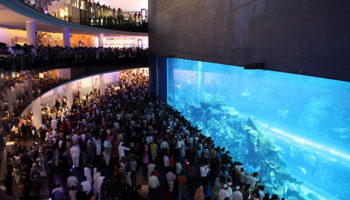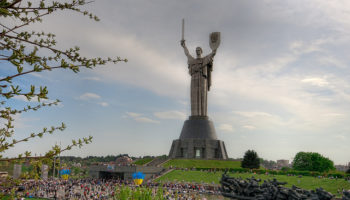Back before most churches existed, early Christians would gather in neighbourhood homes known as house churches. In fact, the word ‘church’ was also used to describe the Christian community as a whole – the word itself means ‘assembly’ in Greek.
By the 1st-century AD, there were already several religious centers in the Holy Land but most of the Christian churches as we know them today began to spread across the globe after the 2nd century From the world-famous St. Peter’s Basilica in the Vatican City to the birthplace of Jesus Christ in Bethlehem, these are the oldest churches in the world.
10. Mor Gabriel Monastery (397)
 © Resul Muslu / Dreamstime
© Resul Muslu / DreamstimeDating back to 397, the Mor Gabriel Monastery is the oldest functioning Syriac Orthodox monastery left on Earth. Perched on the Tur Abdin plateau amongst rolling orchards and olive groves in south-eastern Turkey, this Christian church and the fortress-like compound has long served as a place of refuge.
The monastery, also known as Deyrulumur, has provided a home and sacred space for thousands of Coptic monks and at one stage even had its own diocese. In the 14th-century it was invaded by Timur Mongols, and in the 1990s, hundreds of monks were discovered buried in caves beneath the building.
Today, Dayro d-Mor Gabriel is still home to a handful of dutiful monks and nuns and is the seat of the metropolitan bishop of Turabdin. It’s open to visitors during daylight hours, and there is an opportunity to stay overnight, but only with advanced permission.
9. Monastery of Saint Anthony (356)
 © Danilo Mongiello / Dreamstime
© Danilo Mongiello / DreamstimeThe Monastery of Saint Anthony dates back to the 4th-century. It had humble beginnings as an informal gathering of the followers of Saint Anthony – the first Christian monk – who gathered in a small cave at the foot of Gebel Al Galala Al Qibliya in Egypt’s Eastern Desert. Slowly, the compound expanded to include five historic churches, a bakery, library, and garden oasis within fortified walls.
Today, the monastery is home to over 100 monks, who have chosen a life of meditation and prayer in the isolation of the desert. They live in cells inside the complex and still practise the traditions set out by the original followers of Saint Anthony thousands of years ago.
Several of the original churches have been restored. The Monastery of St Anthony is the oldest building, and the main reason for visiting this remote part of the globe. Built over the saint’s tomb, it’s home to a collection of age-old medieval Coptic wall paintings.
Visitors can join hundreds of pilgrims visiting daily on a tour led by resident monks through the fortified walls of the monastery.
8. Santa Maria in Trastevere (340)

Hailing back to 340, Santa Maria in Trastevere, Rome, is one of the earliest churches in Rome dedicated to the Virgin Mary.
While the oldest parts of the church date back to the 3rd-century, additional features were added in the 12th-century. These include the Romanesque bell tower, a series of interior mosaics, and a beautiful golden façade. The portico was added in the 18th-century.
There are many captivating highlights tempting historians and pilgrims from all over the world to this Roman church. Indubitably, the 12th-century mosaics are the pinnacle – a series of six spectacular mosaics by Pietro Cavallini that document the life of the Virgin Mary.
7. Cathedral of Trier (340)
 © Sergii Figurnyi / Dreamstime
© Sergii Figurnyi / DreamstimeOriginally built in the 4th-century, the Roman Catholic Cathedral of Trier has been expanded over the course of thousands of years. It remains the oldest bishop’s church in Germany and the largest religious building in Trier. Located above a former palace that was later converted into an ancient Christian church, one of the first Early Christian rooms north of the Alps can still be found beneath the cathedral.
The pride and joy of the Cathedral of Trier is the sacred ‘Holy Robe’ found here that is believed to contain fragments of the tunic of Christ. First mentioned by religious scholars in the 12th-century, it was discovered hundreds of years later when the high altar was opened. This ancient Christian relic remains locked away in an annex and is only revealed on very special occasions.
Apart from the exceptional Romanesque and Gothic architecture, another important relic to be seen in the cathedral is the Holy Nail, believed to have been used during the Crucifixion.
6. Church of the Nativity (339)
 © Antonella865 / Dreamstime
© Antonella865 / DreamstimeBethlehem’s Church of the Nativity is widely believed to be the birthplace of Jesus. Located at the end of the well-trodden pilgrimage route – visited by millions of people every year – the Church of the Nativity is one of the holiest places of Christianity on Earth, and the oldest Christian church still in use.
Built at the mouth of an ancient cave to replace an original church destroyed during a 6th-century revolt, the new church still contains the original red-and-white limestone columns and floor mosaics.
Accessed via a low entranceway known as the Door of Humility (resized to stop looters getting inside on horseback), the church still provides entry to the lantern-lit Grotto of the Nativity. Here, the Chapel of the Manger and the 14-pointed silver star mark the spot where Jesus is said to have been born.
5. Church of the Holy Sepulchre (335)

Crafted out of wood and stone, the beige-coloured Church of the Holy Sepulchre in Jerusalem is marked by a series of striking arches adorned with Crusader crosses. Consecrated in 335, it’s built over two of the most famous sites in Christianity’s history – the biblical Rock of Cavalry (Golgotha) where Christ was nailed to the cross, and the Tomb of the Sepulchre.
Also known as the Church of the Resurrection, the church is one of the most popular pilgrimage sites on Earth with millions making their way here every year. The last four to five stations of the Via Dolorosa, which portray the final episodes of the Passion of Jesus, can be found here.
Out of the four (debatably five) stations, the most famous is the 12th – the Rock of Cavalry, with its protective glass Altar of the Crucifixion through which visitors can touch the sacred rock, and the 14th – the Tomb of the Holy Sepulchre, where Jesus was buried and resurrected. Due to its major religious significance, visitors should dress conservatively to gain entry to the church.
4. St. Peter’s Basilica (333)

Located within a city-state within a city revered for its churches and religious buildings, St. Peter’s Basilica in the Vatican City is by far the most impressive. Dating back to 333 albeit rebuilt in the 16th-century, it’s the largest – and one of the oldest – basilicas in Rome and believed to have been built over the tomb of St. Peter.
Highlights include the central balcony, known as the Loggia della Benedizione, where the Pope speaks to the public on special occasions, and the impressive façade with its 13 statues, including St. John the Baptist and Christ the Redeemer. Within the walls of the enormous church, there are some extraordinary works of art – most notably Michelangelo’s riveting Renaissance sculpture, Pieta (meaning ‘Pity’) that represents the Madonna mourning the loss of the son she holds in her lap – a sculpture worth hundreds of millions.
There’s also Bernini’s Baldachin crafted out of bronze from the Pantheon, and above that, Michelangelo’s dome. Visitors can climb to the rooftop for amazing views over the Vatican and beyond.
3. Stavrovouni Monastery (327-329)
 © Chris Mouyiaris / Dreamstime
© Chris Mouyiaris / DreamstimeThe Stavrovouni Monastery is perched precariously at the top of Stavrovouni, the ‘Mountain of the Cross’. Built sometime between 327 and 329, this ancient monastery is believed to be the oldest on the island of Cyprus.
The main reason pilgrims make the steep journey up to this mountain monastery is because of the piece of the Holy Cross preserved within solid silver inside the church. It was supposedly brought back by St. Helena – the mother of Emperor Constantine – after her travels to Jerusalem.
While women are not permitted to enter the monastery, the trip is worth it for the views of the Mesaoria plain alone, stretching towards the Mediterranean in the distance. While male visitors explore the monastery with its bell tower and arched cloisters, female visitors can visit the smaller Church of the All Saints just outside.
2. Panagia Ekatontapiliani (326)
 © Fagundes / Dreamstime
© Fagundes / DreamstimeThe Panagia Ekatontapiliani, which means ‘the Church with a Hundred Doors,’ is one of the most incredible Paleo-Christian monuments of the Cyclades. Located on the island of Paros in Greece, the complex of Ekatontapiliani encompasses a series of churches and chapels, some of which date back to 326 AD.
According to legend, there are 99 doors within the complex. The last, a secret door, will open when the church of Hagia Sofia in Constantinople is once again Orthodox. Explore the main church of the Virgin Mary, Agios Nikolaos – the largest – with its enormous Parian marble columns and the ancient Baptistery.
1. Etchmiadzin Cathedral (301)
 © Arutyunyan / Dreamstime
© Arutyunyan / DreamstimeConsecrated in 301 AD, the Etchmiadzin Cathedral is believed to be the oldest Christian cathedral on Earth, and the Vatican of the Armenian Apostolic Church.
The original church was built over a pagan temple at a time when Christianity became the state religion as enforced by King Tiridates III but later fell into disrepair. It has been rebuilt several times throughout different centuries – therefore showcasing a mixture of several styles of Armenian architecture.
Today, the main cathedral is tucked within manicured hedges and lawns surrounded by more modern buildings from the 19th-century. The cathedral itself consists of a central cupola adorned with glorious, glittering frescoes, and a Treasury where a series of holy relics such as the Holy Lance and a remnant of Noah’s ark can be found.
The cathedral hosts the Catholicos, the administrative head of the Armenian Church, and served as a refuge for Turkish Armenian refugees during the Armenian Genocide. Today, a Genocide Monument can be found within the cathedral’s beautifully landscaped gardens.










Leave a Reply